Alexander Graham Bell invented the telephone, or did he? The truth isn’t nearly as clear as we’ve been taught. In fact, in America, it was a dead heat to the patent office. The telephone isn’t the only invention with murky origins. Consider wireless, the light bulb, flying machines and the list goes on. Why is that so many great inventions seem to have multiple claimants for design credit?

Badge Holder
Industrial spies maybe? That would have been my guess until the same thing happened to me. Oh, nothing as life altering as the telephone but the experience was certainly eye opening. My story begins with a straightforward workplace contest designed to spotlight the versatility of our 3D printers, print a badge holder.
We were allowed to use a design from Thingiverse or Printables, design it ourselves, or use AI. Credit would be given for innovation, style and print difficulty. Like I said, it was wide open and fraught with possibilities to produce identical entries. Of course, I immediately turned to AI and used Google’s BARD to produce an OpenScade model. After a little debugging, I realized BARD had given me a small box to lay my badge in. It was exactly what I asked for but far from what I envisioned. The frustration did provide me with greater insight into the way my wife often feels when I complete a project for her.
With the deadline looming, I chose a small snap-together box from Thingiverse, modified its dimensions, made a cutout in the front, and I had a badge holder. It was easy but hardly a winning design. Have I mentioned I hate losing? I needed shock and awe.
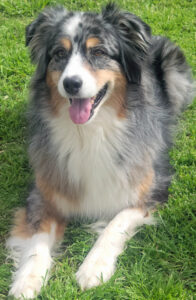
Ronin, no guitar talent
On a quick but important sideline, I’ve been fighting an issue with my Wyze cameras. I have four of them on solar power. If the USB voltage rises slowly, the camera may or may not power up correctly. It’s massive overkill, but after many attempts with Zeners and relays, I arrived at an Arduino processor to ensure startup. Going for small size and cheap, I was using a SeeedStudio XIAO. My C++ coding ability being about on par with Ronin’s ability to play the guitar, i.e., zero, I turned to ChatGPT for the code necessary to incorporate a small display for debugging purposes.
That was my current workbench: a small footprint processor, a small display, and an insipid badge holder design. Although my path to this point was undoubtedly unique, it was hardly a case of divine inspiration to combine them into a badge holder with a display. Of course, a few changes had to be made. I needed a smaller battery than the 10 Amp/hour batteries I was using and the display needed to be smaller too. A little Wi-Fi capability wouldn’t hurt and I definitely needed a way to charge the battery.
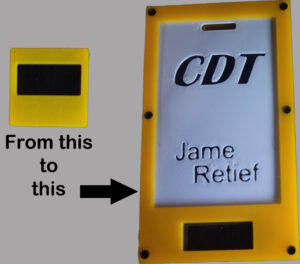
From small beginnings. Yes, I also printed the badge.
Enter the SeeedStudio ESP32C3, low power operation, built-in Wi-Fi capability, and approximately the same footprint as the XIAO. It helped that my code was transportable between the two processors.
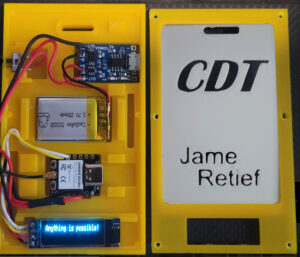
My design, inside and out
Component placement, switch placement, wiring channels, and a learning curve; let’s just say I proved my printer’s worth as I constantly refined the case design. Once again leaning heavily on ChatGPT for the C++ coding, I ended up with a badge holder, capable of displaying two lines of random inspirational text that could be changed by using a magnet. Using the WIFI function, I added a personalized message for the contest judges if my phone’s hotspot was detected. Given the journey, I was confident I had a unique design.
Remember the multiple claimants I discussed earlier? I was stunned when another engineer entered an identical design. Oh, it was a different color and had a few cosmetic differences, but all in all, they looked closer than two identical car models with minor trim differences.
Function drives form, but this was ridiculous. I had not discussed my design with anyone but my wife. You just read the path to my design. Unless I had been hacked, industrial spies were out. Yet, if we had made these from a kit, they could not have been more identical. Even the display, the on-off switch, and the charging port were in the same places.
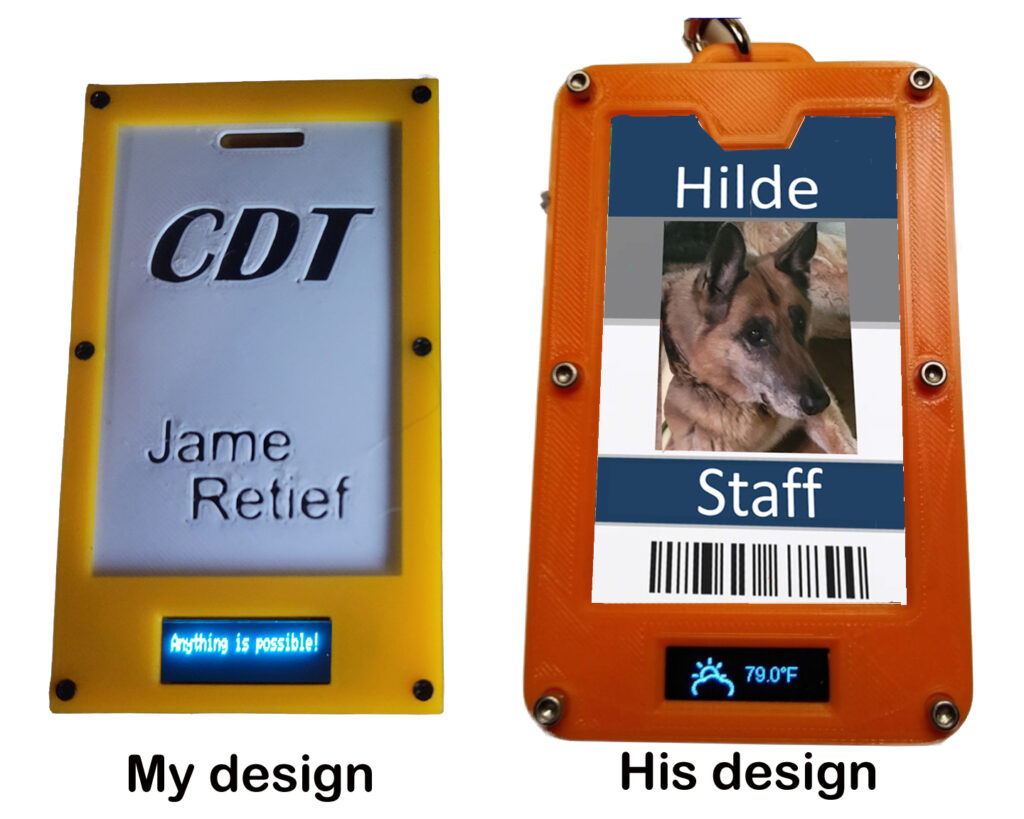
Unfortunately, his command of C++ was better than my own and rather than display inspirational messages, his displayed weather. On the other hand, driven by my baser instincts and guided by engineering behavior everywhere, I had added the Wi-Fi capability to announce the availability of food in specific areas.
I won the competition, but only because I was very careful to follow all the rules and he had failed to comply with one line.
Three takeaways from this:
- If you intend to compete, always read the rules completely. A superior design won’t win if the rules are not followed.
- Coincidence does happen, especially in the engineering world. With no communication between us, the influencing factor was the availability of technology. Driven by available technology, it was no surprise that our designs were almost identical.
- Nothing I did exceeded the capability of most people. I used components readily available from Amazon, programming from a huge Arduino community, and a willingness to keep modifying my 3D design as the design evolved. With ChatGPT at my side, the highest levels of technology I actually demonstrated were my soldering skills and a willingness to do research.
Conclusion:
It’s no longer amazing or even surprising that credit for so many designs and discoveries is hotly contested. My experience here shows that two people with widely divergent talents and no correspondence can come up with almost identical designs. Function and available technology drove our commonality. It does make you wonder what would have changed if Mr. Bell had been one day later in submitting his patent, maybe nothing.
In case you’re interested, a few design details:
- Seeed Studio ESP32C3: https://www.seeedstudio.com/Seeed-XIAO-ESP32C3-p-5431.html
- Rechargeable 3.7V Li Lipo Lithium Polymer Ion Battery Pack: https://www.amazon.com/gp/product/B091FBD9KZ
- TP4056 Charging Module Micro USB 18650 Lithium Battery Charger: https://www.amazon.com/gp/product/B08MT6567Z
- Magnetic Reed Switch: https://www.amazon.com/gp/product/B071RYZ64N
- 128×32 OLED Display: https://www.amazon.com/gp/product/B08JPYJ35Y
- SPDT Mini Micro Slide Switch: https://www.amazon.com/gp/product/B09R43HCY3
- Speaker 0.5W 8 Ohm 10mm Diameter (Never implemented): https://www.amazon.com/gp/product/B082762Y5W
The schematic is almost self explanatory but if you find yourself struggling send me a request and I’ll create one. Similarly, there’s nothing special about the code. If you really find yourself stuck, I’ll clean mine up slightly and send it.
As a final word, as I was researching how to use the WIFI capability of my ESP32C3, I ran across https://randomnerdtutorials.com. They had nothing I implemented but they did show me how I could have used a spare remote control to select messages.
© 2023, Byron Seastrunk. All rights reserved.

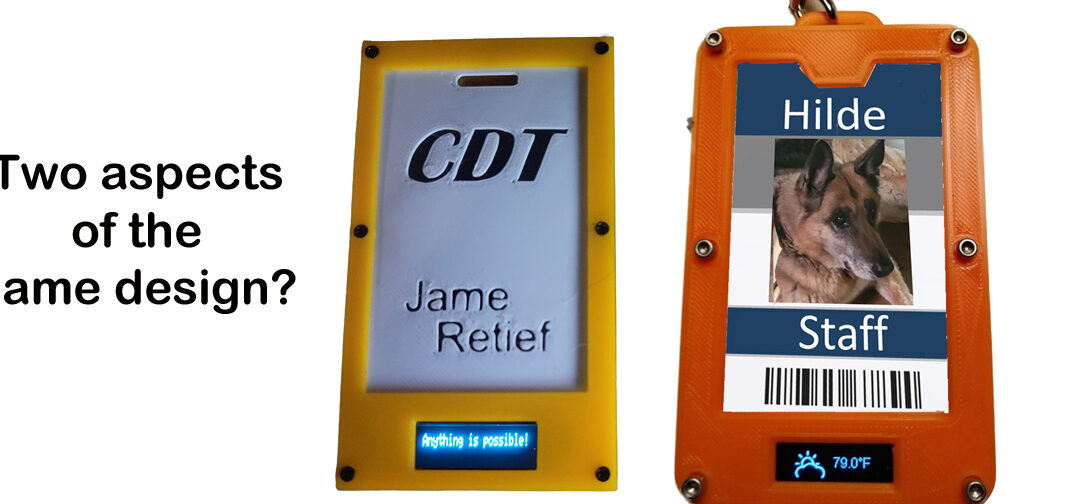









Recent Comments